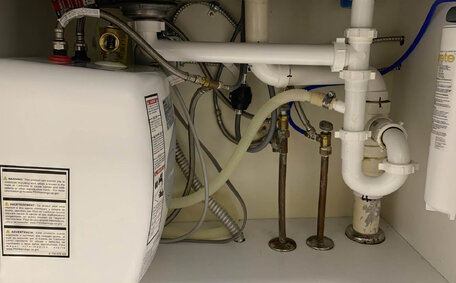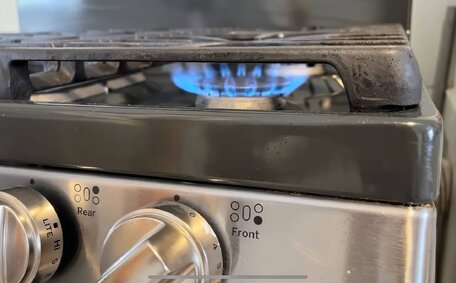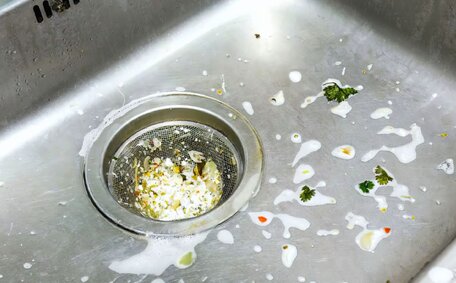Understanding Gas Appliance Energy Usage
Common household gas appliances include systems for heating hot water, cooking, space and water heating systems, stoves, ovens, cooktops, and pool and spa heaters. These appliances use natural gas or LPG to generate heat, and understanding how to optimise their performance can help save on your home’s overall energy use. Find out how to mitigate this impact and take action with efficient use. Gas appliances account for a considerable portion of household energy consumption, measured in megajoules (MJ) or kilowatt hours (kWh).
Factors influencing gas appliance efficiency include the age and condition of the appliance, insulation, temperature settings, usage patterns, and more. Newer models contribute greatly to your household energy conservation, allowing you to save on costs as they’re more efficient than their older counterparts. By properly maintaining appliances and using energy-saving temperature settings, you can enhance your home’s efficiency.
Switching to efficient electric alternatives such as reverse-cycle air conditioners, heat pumps, and induction cooktops can lower electricity costs and eliminate annual gas connection fees. While upfront costs are higher, considering cost per year through gas-electric comparisons reveals that electricity is often more cost-effective per megajoule than natural gas from the grid.
Improving Efficiency of Existing Gas Appliances
Here are some tips for improving the efficiency of existing gas appliances in your home:
Regular maintenance
Have your appliances serviced regularly according to manufacturer guidelines to maintain peak efficiency. Things like cleaning burners, changing filters, and ensuring proper ventilation can optimise efficiency.
Adjust temperatures
Set your heater and water heater thermostats to 60°C and space heaters to 18-20°C. Opting for lower temperatures can reduce your energy use and gas usage, leading to more sustainable living. Conserve energy in your heating practices by turning off heaters and other appliances when they’re not actively needed.
Upgrade old models
Replace your old appliances with energy efficient appliances to save around 10-30% on gas. Look for the energy rating label.
Use efficiently
Maximise efficient appliance use by only heating as much water as needed, washing only full loads and ensuring your dishwasher is full before running; these habits make a substantial energy-saving difference. Using your appliances at optimal times, especially hot water, can enhance your home’s eco-friendliness and reduce energy waste.
Simple upgrades like door seals and using lids on pots for heating hot water cooking can retain more heat and make a noticeable difference. Using an energy monitoring app helps you identify which appliances, like air conditioners, are the largest energy consumers.
Efficient gas appliances, when used mindfully, play a significant role in cutting energy costs and promoting responsible energy consumption. If replacing appliances, consider modern electric alternatives which are cheaper and more sustainable long-term.
Sealing Draughts
Draught sealing involves blocking gaps and cracks that allow warm air to escape and cold air to enter the home. This effective strategy can lower your heat loss, ultimately reducing your energy use for heating appliances. Common areas for draughts include key points like windows doors, vents, pipe penetrations, cracks in walls/floors, and fireplaces.
DIY sealing tips
Discover what you can do with easy ways to perform basic draught sealing as a rewarding DIY project. Things like weatherstripping around doors/windows, caulking cracks, and fitting draught excluders to vents are easy fixes. Make sure to use appropriate, high-quality sealing materials for best results.
Professional assistance
Well-targeted draught sealing improves home comfort all year round. Mitigating preventable heat loss enables your heating appliances to operate more efficiently and at the same time, reduce your energy bills.
Setting Appropriate Temperatures
Setting appropriate temperatures for your gas appliances can have a significant impact to reduce energy usage and enhance energy efficiency.
Likewise, adjusting your hot water systems to a 60°C thermostat setting ensures safe water while it minimises gas use.
Programmable thermostats allow increased temperatures at home when needed. Ensure heaters are switched off in unused rooms too.
Lowering heating settings when leaving home or sleeping can markedly improve energy conservation.
Setting your pool and hot tub temperatures to 26–28°C can reduce gas consumption substantially. Until your pool requires heating, use an insulated cover to maintain temperature and avoid unnecessary energy expenditure.
Finding the sweet spot with temperature settings gives you the warm water and heating you need, while cutting unnecessary gas usage. Small adjustments to thermostats and usage patterns can significantly reduce energy waste without compromising comfort. Consult our technicians at Jamisontown Plumbing if you need help adjusting appliance thermostat settings for optimal efficiency.
Using Energy-Efficient Kitchen Appliances
When it comes to kitchen appliances, upgrading to energy-efficient models can make a significant difference in gas usage and costs. Today’s modern gas stove ovens and cooktops boast improved burner insulation, pilotless ignition, and accurate thermostat controls that greatly enhance efficiency.
A new 6-star energy-rated gas stove, in contrast with an older 2-star model, can decrease home energy expenses by 20-30% on cooking fuel, equating to direct savings. That’s money back in your pocket.
Consider induction cooking
To increase efficiency and save on utility bills, consider switching to modern induction cooktops and ovens. Induction directly heats pots and pans using electromagnetic energy, rather than heating the surface itself.
This results in quicker cooking times and more precise temperature control, while using roughly half the energy of gas appliances. And there’s no open flame, less ambient heat in summer and easier cleaning. An added perk is that the running costs for these modern electric appliances typically cost less than their gas counterparts, depending on your electricity rates.
Small upgrades make a worthwhile difference.
Transitioning to Efficient Electric Alternatives
There are compelling reasons to transition from traditional gas appliances to efficient electric alternatives like reverse-cycle air conditioners and heat pumps, which use less energy for both water and space heating.
Key benefits of switching to electric include:
- Lower running costs - electricity is cheaper than gas per megajoule of energy consumption from the grid in most areas
- Enhanced efficiency - heat pumps can be over 300% efficient by leveraging renewable ambient energy, and induction transfers 90% of energy straight to cookware
- Improved sustainability - electricity from solar or the grid often has lower carbon emissions than gas
Making the switch not only eliminates annual gas connection fees but also can save considerably in the long run. And with government rebates, payback periods for new systems are getting shorter.
Replacing an old gas ducted heating system with a modern reverse-cycle air conditioner can achieve significant savings, reducing heating costs by 50-70%. Factoring rebates, it pays for itself in 5 years or less.
Transitioning key appliances to efficient electric alternatives like heat pumps and induction is the best way to enhance energy efficiency, save money long-term, and reduce your carbon footprint.
For tips using energy efficiently within your budget, our Jamisontown Plumbing technicians offer personalized consultations on suitable home systems.
Heat Pumps
Heat pumps represent advanced heating cooling solutions, being an energy-efficient electric technology for both homes and hot water service. They excel in heating hot and cool spaces by transferring ambient heat between indoor and outdoor air or from the ground into buildings.
There are three main types of heat pumps:
- Air source heat pumps that harness heat from outdoor air
- Ground source heat pumps tapping into warmth in soil underground
- Hot water heat pump systems that extract heat from air to warm water
Compared to traditional gas appliances, heat pumps can reduce heating costs substantially thanks to higher efficiency. Heat pumps are remarkably efficient; they can produce more than 3 units of heating or cooling energy for every unit of electricity consumed. This is a 300-400% efficiency rate.
Replacing an older gas water heater with a heat pump system cuts water heating costs by about 60%. And swapping out a gas furnace for an electric air source heat pump maintains your hot living space while saving 50-70% on heating costs. Using heat pumps during peak times can also contribute to better energy management and have some of the lowest greenhouse gas emissions.
Given the variations in the gas market and increasing gas prices, contemporary heat pump technology emerges as a highly cost-effective and sustainable option for year-round home temperature control.
Induction Cooktops
Induction cooktops are an energy-efficient alternative to traditional gas cooktops. They use electromagnetic energy to directly heat ferromagnetic material pots and pans placed on the cooktop’s surface.
This means induction cooktops focus much energy on heating the cookware exclusively via electromagnetic energy, instead of warming the entire cooktop surface as gas does. As a result, they are much more efficient. Induction cooktops remarkably direct 90% of the energy used to heating the pot or pan, which is far superior to gas cooktops, where less than 40% of energy serves this purpose.
Induction also enables faster, more precise temperature control and cooking. And you’re better off with the cooktop surface that stays cooler while in use. Induction technology combined with ferromagnetic material woks allows for incredibly fast and efficient heat-up for flash frying and stir-frying.
By switching from an older gas cooktop to a modern induction model, households can reduce cooking energy consumption by 40-60%. This saves money while being better for the environment. With rising gas prices, induction cooktops make an energy- and cost-efficient upgrade.
Leveraging Technology and Government Rebates
Check out our guide on how technology and government rebates can help make upgrading appliances more affordable. Energy rating apps allow you to easily compare the efficiency of different models. Websites like EnergyMadeEasy from the Australian Government provide impartial advice on finding deals.
Available rebates
In Jamisontown, Sydney, households can access rebates like the Sustainable Household Scheme. This provides up to $1,000 credit towards installing efficient electric appliances. Rebates significantly reduce payback periods.
Combining rebates with sale prices on upgraded gas systems and appliances increases cost-effectiveness. An advanced heat pump water heater that might cost about $2,000 could be subject to a $500 rebate, enhancing affordability. That lowers the out-of-pocket cost to $1,500 installed.
Enlist our team at Jamisontown Plumbing to help you stay top of your quest for savings and discover more about eligible rebates. We help you stay top of the latest government incentives and advise on the most cost-effective electric appliance upgrades to help you save.
Energy Rating Apps
Apps such as Canstar Blue’s Energy Made Easy enable households to effortlessly compare the efficiency of appliances, which is invaluable when making new purchases or evaluating current models.
These apps provide impartial ratings across thousands of appliances and can guide you to use more energy efficient models based on real-world testing. Ratings are presented on an easily understandable 1 to 10 star scale for energy efficiency. The more stars, the less energy an appliance uses.
Checking an appliance’s star rating in an energy app helps save on future expenses by giving clarity on potential running costs and carbon emissions. It empowers consumers to make well-informed decisions on upgrading to more efficient models. It also helps households better understand their current appliances’ performance.
Upgrading from a 2-star gas storage hot water system to a 5-star heat pump model can slash water heating costs by approximately 60%, a testament to superior efficiency. Apps make these comparisons straightforward.
The use of energy rating apps facilitates smarter, more eco-friendly decisions on appliance upgrades and enables efficient evaluation of existing appliances.
Government Rebates for Upgrades
Both the Australian and ACT Government offer generous rebates to help households upgrade appliances and systems to more energy-efficient electric alternatives.
Key rebates available
In NSW, key rebates include:
- Up to $1,000 off installing a heat pump hot water system
- $500 rebate for a reverse cycle split system air conditioner
- $840 discount on replacing an electric storage hot water system with a heat pump
- $500 credit for an energy-efficient washing machine or fridge
Moreover, rebates of up to $3,500 are available for installing solar panels via rooftop solar PV systems under the Smart Energy Council’s Solar Homes initiatives.
Eligibility and applications
Contact our team at Jamisontown Plumbing to check your eligibility and assistance with preparing and submitting applications. Our licenced technicians can also provide advice on products and install your upgrades professionally.
With generous incentives available, now is the time to keep your home cool by transitioning outdated gas appliances to cost-saving efficient electric alternatives with lower running costs and emissions.






